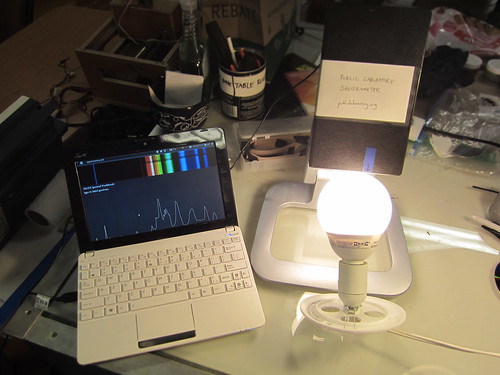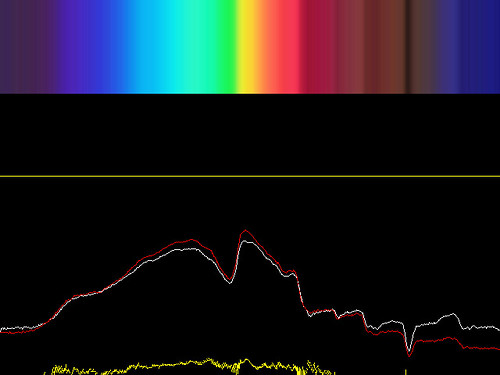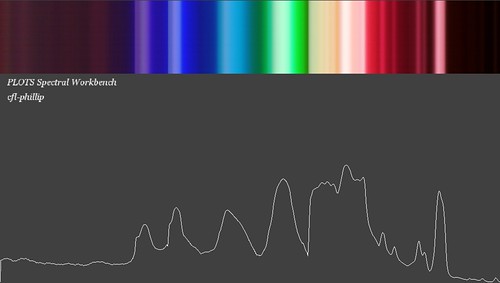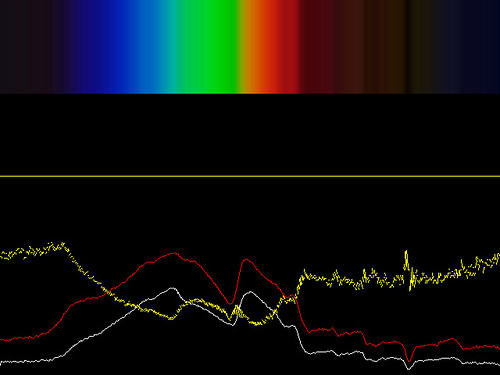 This spectrometer is made with cardboard inserts inside an old VHS box, and uses a USB webcam. This allows the user to view the spectrum in real-time, rather than taking a photo and analyzing it later. Please get in touch with jeff@publiclaboratory.org if you'd like to help work on this!
##Specs##
(these are approximated but we should soon post a page with calibration information)
* around 400-900nm, maybe wider
* 5-10nm spectral resolution
* 20-30 samples per second
* around $30 in materials, drops to around $10 if you use a non-HD webcam
* approx. 1 hour construction time
* Mac and Linux compatible, should work on Windows but untested
* open-source software at: http://github.com/jywarren/spectral-workbench
##Goals##
Our early goals are to:
* Identify a contaminant in a sample, like Polycyclic Aromatic Hydrocarbons -- like [naphthalene, anthracene and tetracene](http://publiclaboratory.org/notes/warren/8-5-2011/uv-visible-spectral-features-benzine-and-some-pahs). Tetracene has absorption bands well into the visible range.
* Identify a plant species by its spectrum. (see [this helpful paper by Zomer et al](https://publiclab.org/sites/default/files/Zomer_2009.PDF)) Or perhaps a mineral, using the [ASTER spectral library](http://archive.publiclaboratory.org/aster-spectral-library/)
* Try to identify something in a smokestack plume, like a refinery plume
##How to build your own##
###Software###
Download the client software (Linux/Mac, may work in Windows with a little work) here: http://github.com/jywarren/spectral-workbench
###Hardware###
Instructions on building your spectrometer can be found at:
###[Video Spectrometer Construction »](/wiki/video-spectrometer-construction)###
##Using your spectrometer##
You'll need to calibrate it first; the best way is probably to use a known spectrum from a compact fluorescent light bulb, and to compare it to your spectrum like this: http://publiclaboratory.org/notes/warren/7-28-2011/live-spectral-analysis-code-good-resolution
_more soon_
##To do##
* find a way to find a spectrum similar to a recorded sample spectrum, from a library of spectra like the [ASTER library](http://archive.publiclaboratory.org/aster-spectral-library/) or the [HITRAN library](http://archive.publiclaboratory.org/hitran-spectral-library/)
* create a website to upload spectra to, -- even better, allow them to be sorted into "sets", and allow comments on each spectrum by other users. See [the source code](http://github.com/jywarren/spectral-workbench) for where we've started work
##Spectrum gallery##
Some spectra captured with one of these devices. If you begin taking spectra, start uploading them to Flickr with the tag #diyspectrometer -- we'll soon have a place to automatically upload them, but this will work for now.
An example spectrum (one of our best yet!):
This spectrometer is made with cardboard inserts inside an old VHS box, and uses a USB webcam. This allows the user to view the spectrum in real-time, rather than taking a photo and analyzing it later. Please get in touch with jeff@publiclaboratory.org if you'd like to help work on this!
##Specs##
(these are approximated but we should soon post a page with calibration information)
* around 400-900nm, maybe wider
* 5-10nm spectral resolution
* 20-30 samples per second
* around $30 in materials, drops to around $10 if you use a non-HD webcam
* approx. 1 hour construction time
* Mac and Linux compatible, should work on Windows but untested
* open-source software at: http://github.com/jywarren/spectral-workbench
##Goals##
Our early goals are to:
* Identify a contaminant in a sample, like Polycyclic Aromatic Hydrocarbons -- like [naphthalene, anthracene and tetracene](http://publiclaboratory.org/notes/warren/8-5-2011/uv-visible-spectral-features-benzine-and-some-pahs). Tetracene has absorption bands well into the visible range.
* Identify a plant species by its spectrum. (see [this helpful paper by Zomer et al](https://publiclab.org/sites/default/files/Zomer_2009.PDF)) Or perhaps a mineral, using the [ASTER spectral library](http://archive.publiclaboratory.org/aster-spectral-library/)
* Try to identify something in a smokestack plume, like a refinery plume
##How to build your own##
###Software###
Download the client software (Linux/Mac, may work in Windows with a little work) here: http://github.com/jywarren/spectral-workbench
###Hardware###
Instructions on building your spectrometer can be found at:
###[Video Spectrometer Construction »](/wiki/video-spectrometer-construction)###
##Using your spectrometer##
You'll need to calibrate it first; the best way is probably to use a known spectrum from a compact fluorescent light bulb, and to compare it to your spectrum like this: http://publiclaboratory.org/notes/warren/7-28-2011/live-spectral-analysis-code-good-resolution
_more soon_
##To do##
* find a way to find a spectrum similar to a recorded sample spectrum, from a library of spectra like the [ASTER library](http://archive.publiclaboratory.org/aster-spectral-library/) or the [HITRAN library](http://archive.publiclaboratory.org/hitran-spectral-library/)
* create a website to upload spectra to, -- even better, allow them to be sorted into "sets", and allow comments on each spectrum by other users. See [the source code](http://github.com/jywarren/spectral-workbench) for where we've started work
##Spectrum gallery##
Some spectra captured with one of these devices. If you begin taking spectra, start uploading them to Flickr with the tag #diyspectrometer -- we'll soon have a place to automatically upload them, but this will work for now.
An example spectrum (one of our best yet!):
 A Philips "warm" compact fluorescent bulb:
A Philips "warm" compact fluorescent bulb:
 Spectrum of sunlight through water from a puddle at the Gowanus Canal salt lot:
Spectrum of sunlight through water from a puddle at the Gowanus Canal salt lot:

 This spectrometer is made with cardboard inserts inside an old VHS box, and uses a USB webcam. This allows the user to view the spectrum in real-time, rather than taking a photo and analyzing it later. Please get in touch with jeff@publiclaboratory.org if you'd like to help work on this!
##Specs##
(these are approximated but we should soon post a page with calibration information)
* around 400-900nm, maybe wider
* 5-10nm spectral resolution
* 20-30 samples per second
* around $30 in materials, drops to around $10 if you use a non-HD webcam
* approx. 1 hour construction time
* Mac and Linux compatible, should work on Windows but untested
* open-source software at: http://github.com/jywarren/spectral-workbench
##Goals##
Our early goals are to:
* Identify a contaminant in a sample, like Polycyclic Aromatic Hydrocarbons -- like [naphthalene, anthracene and tetracene](http://publiclaboratory.org/notes/warren/8-5-2011/uv-visible-spectral-features-benzine-and-some-pahs). Tetracene has absorption bands well into the visible range.
* Identify a plant species by its spectrum. (see [this helpful paper by Zomer et al](https://publiclab.org/sites/default/files/Zomer_2009.PDF)) Or perhaps a mineral, using the [ASTER spectral library](http://archive.publiclaboratory.org/aster-spectral-library/)
* Try to identify something in a smokestack plume, like a refinery plume
##How to build your own##
###Software###
Download the client software (Linux/Mac, may work in Windows with a little work) here: http://github.com/jywarren/spectral-workbench
###Hardware###
Instructions on building your spectrometer can be found at:
###[Video Spectrometer Construction »](/wiki/video-spectrometer-construction)###
##Using your spectrometer##
You'll need to calibrate it first; the best way is probably to use a known spectrum from a compact fluorescent light bulb, and to compare it to your spectrum like this: http://publiclaboratory.org/notes/warren/7-28-2011/live-spectral-analysis-code-good-resolution
_more soon_
##To do##
* find a way to find a spectrum similar to a recorded sample spectrum, from a library of spectra like the [ASTER library](http://archive.publiclaboratory.org/aster-spectral-library/) or the [HITRAN library](http://archive.publiclaboratory.org/hitran-spectral-library/)
* create a website to upload spectra to, -- even better, allow them to be sorted into "sets", and allow comments on each spectrum by other users. See [the source code](http://github.com/jywarren/spectral-workbench) for where we've started work
##Spectrum gallery##
Some spectra captured with one of these devices. If you begin taking spectra, start uploading them to Flickr with the tag #diyspectrometer -- we'll soon have a place to automatically upload them, but this will work for now.
An example spectrum (one of our best yet!):
This spectrometer is made with cardboard inserts inside an old VHS box, and uses a USB webcam. This allows the user to view the spectrum in real-time, rather than taking a photo and analyzing it later. Please get in touch with jeff@publiclaboratory.org if you'd like to help work on this!
##Specs##
(these are approximated but we should soon post a page with calibration information)
* around 400-900nm, maybe wider
* 5-10nm spectral resolution
* 20-30 samples per second
* around $30 in materials, drops to around $10 if you use a non-HD webcam
* approx. 1 hour construction time
* Mac and Linux compatible, should work on Windows but untested
* open-source software at: http://github.com/jywarren/spectral-workbench
##Goals##
Our early goals are to:
* Identify a contaminant in a sample, like Polycyclic Aromatic Hydrocarbons -- like [naphthalene, anthracene and tetracene](http://publiclaboratory.org/notes/warren/8-5-2011/uv-visible-spectral-features-benzine-and-some-pahs). Tetracene has absorption bands well into the visible range.
* Identify a plant species by its spectrum. (see [this helpful paper by Zomer et al](https://publiclab.org/sites/default/files/Zomer_2009.PDF)) Or perhaps a mineral, using the [ASTER spectral library](http://archive.publiclaboratory.org/aster-spectral-library/)
* Try to identify something in a smokestack plume, like a refinery plume
##How to build your own##
###Software###
Download the client software (Linux/Mac, may work in Windows with a little work) here: http://github.com/jywarren/spectral-workbench
###Hardware###
Instructions on building your spectrometer can be found at:
###[Video Spectrometer Construction »](/wiki/video-spectrometer-construction)###
##Using your spectrometer##
You'll need to calibrate it first; the best way is probably to use a known spectrum from a compact fluorescent light bulb, and to compare it to your spectrum like this: http://publiclaboratory.org/notes/warren/7-28-2011/live-spectral-analysis-code-good-resolution
_more soon_
##To do##
* find a way to find a spectrum similar to a recorded sample spectrum, from a library of spectra like the [ASTER library](http://archive.publiclaboratory.org/aster-spectral-library/) or the [HITRAN library](http://archive.publiclaboratory.org/hitran-spectral-library/)
* create a website to upload spectra to, -- even better, allow them to be sorted into "sets", and allow comments on each spectrum by other users. See [the source code](http://github.com/jywarren/spectral-workbench) for where we've started work
##Spectrum gallery##
Some spectra captured with one of these devices. If you begin taking spectra, start uploading them to Flickr with the tag #diyspectrometer -- we'll soon have a place to automatically upload them, but this will work for now.
An example spectrum (one of our best yet!):
 A Philips "warm" compact fluorescent bulb:
A Philips "warm" compact fluorescent bulb:
 Spectrum of sunlight through water from a puddle at the Gowanus Canal salt lot:
Spectrum of sunlight through water from a puddle at the Gowanus Canal salt lot:
